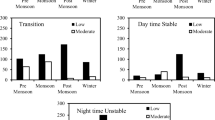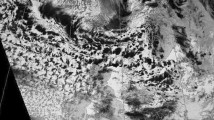Abstract
Turbulent data from three sites are utilized to analyze the characteristic features of the Eulerian autocorrelation function (EAF) of horizontal (longitudinal and lateral) wind components and temperature under different regimes of wind speed and near-surface atmospheric stability. It is shown that classical formulations do not adequately describe the observed EAF behaviour and are unable to capture the peak of the significant negative observed lobe. These formulations are modified by introducing a phase angle \(\alpha\) to make them consistent with the observations. The modified formulations are shown to better characterize the behaviour of the EAF curve and its absolute value of significant negative lobe (\(\left|{R}_{Min}\right|\)) for both low and moderate wind conditions for all three datasets. Further, a new parametrization for the meandering parameter m is proposed in terms of the observed value of \(\left|{R}_{Min}\right|\) without using any formulations for the EAF. It is found that the majority of low and moderate wind data belong to the significant meandering range, although the extent of meandering is found to be relatively more pronounced at low wind speeds as compared to moderate wind speeds. The occurrence of meandering (low-frequency horizontal wind oscillations) is found to be independent of stability, topography, and geographical location.





Similar content being viewed by others
References
Agarwal P, Yadav A, Gulati A, Raman S, Rao S, Singh M, Nigam S, Reddy N (1995) Surface layer turbulence processes in low wind speeds over land. Atmos Environ 29:2089–2098
Anfossi D, Oettl D, Degrazia G (2004) Some Aspects of Turbulence and Dispersion in Low Wind Speed Conditions. Air Pollution Modelling and Its Application XVI. Springer, Boston, MA. https://doi.org/10.1007/978-1-4419-8867-6_30
Anfossi D, Oettl D, Degrazia G, Goulart A (2005) An analysis of sonic anemometer observations in low wind speed conditions. Boundary-Layer Meteorol 114:179–203
Anfossi D, Alessandrini S, Trini S, Ferrero E, Oettl D, Degrazia G (2006) Tracer dispersion simulation in low wind speed conditions with a new 2-D Langevin equation system. Atmos Environ 40:7234–7245
Brusasca G, Tinarelli G, Anfossi D (1992) Particle model simulation of diffusion in low wind speed stable conditions. Atmos Environ 26 A:707–723
Deardorff J (1970) Preliminary results from numerical integrations of the unstable boundary layer. J Atmos Sci 27:1209–1211
Dwivedi A, Chandra S, Kumar M, Kumar S, Kumar N (2014) Spectral analysis of wind and temperature components during lightning in pre-monsoon season over Ranchi. Meteorol Atmos Phys 127:95–105
Frenkiel F (1953) Turbulent Diffusion: Mean Concentration Distribution in a Flow Field of Homogeneous Turbulence. Adv Appl Mech 3:61–107
Kelly S (2012) Mechanical Vibrations: Theory and Applications, Cengage Learning: 672
Kumar P, Sharan M (2012) An analysis for the applicability of Monin-Obukhov similarity theory in stable conditions. J Atmos Sci 69:1910–1915
Moor L, Degrazia G, Stefanello M, Mortarini L, Acevedo O, Maldaner S, Szinvelski S, Roberti D, Buligon L, Anfossi D (2015) Proposal of a new autocorrelation function in low wind speed conditions. Physica A 438:286–292
Mortarini L, Ferrero E, Falabino S, Trini S, Richiardone R, Anfossi D (2013) Low-frequency processes and turbulence structure in a perturbed boundary layer. Q J R Meteorol Soc 139:1059–1072. https://doi.org/10.1002/qj.2015
Mortarini L, Anfossi D (2015) Proposal of an empirical velocity spectrum formula in low-wind speed conditions. Q J R Meteorol Soc. https://doi.org/10.1002/qj.2336
Mortarini L, Maldaner S, Moor L, Stefanello M, Acevedo O, Degrazia G, Anfossi D (2016a) Temperature Auto-correlation and Spectra functions in low-wind meandering conditions. Q J R Meteorol Soc 142:1881–1889. https://doi.org/10.1002/qj.2796
Mortarini L, Stefanello M, Degrazia G, Roberti D, Castelli S, Anfossi D (2016b) Characterization of wind meandering in low wind conditions. Boundary-Layer Meteorol 161:165–182. https://doi.org/10.1007/s10546-016-0165-6
Murgatroyd R (1969) Estimations from Geostrophic Trajectories of horizontal diffusivity in the mid-latitude troposphere and lower stratosphere. Q J R Meteorol Soc 95:40–62
Oettl D, Goulart A, Degrazia G, Anfossi D (2005) A new hypothesis on meandering atmospheric flows in low wind speed conditions. Atmos Environ 39:1739–1748
Phillips P, Panofsky H (1982) A re-examination of lateral dispersion from continuous sources. Atmos Environ 16:1851–1859
Pandey V, Kumar M, Sheikh A (2001) Agroclimatic features of LASPEX sites. J Agrometeorol 3:39–55
Poulos G, Blumen W, Fritts D, Lundquist J, Sun J, Burns S (2002) CASES-99: A comprehensive investigation of the stable nocturnal boundary layer. Bull Am Meteorol Soc 83:555–581
Sagendorf J, Dickson D (1974) Diffusion under low wind speed inversion conditions. NOAA Technical memoerl-arl-52. Technical report, Air Resources Laboratories, Silver Spring, MD
Sharan M, Modani M, Yadav A (2003) Atmospheric dispersion: an overview of mathematical modelling framework. Proc Indian National Science Academy Part A Phys Sci 69:725–744
Sharan M, Srivastava P (2016) Characteristics of heat flux in unstable atmospheric surface layer. J Atmos Sci 73:4519–4529
Sharan M, Yadav A, Singh M (1995) Comparison of various sigma schemes for estimating dispersion of air pollutants in low winds. Atmos Environ 29:2051–2059
Sharan M, Yadav A, Singh M (1996) A time dependent mathematical model using coupled puff and segmented approaches. J Appl Meteorol 35:1625–1631
Sheikh A (1997) Agroclimatic Atlas of Gujarat. Gujarat Agricultural University, Anand, India
Taylor G (1921) Diffusion by continuous movements. Proc London Math Soc Ser 2(20):196–211
Tyagi B, Satyanarayana A, Kumar M, Mahanti N (2012) Surface energy and radiation budget over a tropical station: An observational study. Asia-Pac J Atmos Sci 48:411–421. https://doi.org/10.1007/s13143-012-0037-z
Vernekar K, Sinha S, Sadani L, Sivramakrishnan S, Parasnis S, Brij M, Saxena S, Dharamraj T, Patil M, Pillai J, Murthy B, Debaje S, Bagavatsingh A (2003) An overview of the Land Surface Processes Experiment (LASPEX) over a semi-arid region of India. Boundary-Layer Meteorol 106:561–572
Wilczak J, Oncley S, Stage S (2001) Sonic anemometer tilt correction algorithms. Boundary-Layer Meteorol 99:127–150
Yadav A, Sethuraman SM (1996) Surface layer turbulence spectra and eddy dissipation during low winds in tropics. Boundary-Layer Meteorol 79:205–224
Acknowledgements
The authors wish to thank Dr. Manoj Kumar for providing observational data for Ranchi, Indian Institute of Tropical Meteorology Pune for the LASPEX dataset and National Center for Atmospheric Research (NCAR) for CASES-99 observations. Authors thank Dr. Piyush Srivastava for his valuable suggestions. We would also like to thank the reviewers for their valuable comments. The authors declare no competing interests. The turbulence data used in this study can be obtained for Ranchi from the Indian National Centre for Ocean Information Services (http://www.incois.gov.in/portal/datainfo/ctczdata.jsp) upon request and for CASES-99 from the site http://www.eol.ucar.edu/projects/cases99/.
Author information
Authors and Affiliations
Corresponding author
Additional information
Publisher's Note
Springer Nature remains neutral with regard to jurisdictional claims in published maps and institutional affiliations.
Supplementary Information
Below is the link to the electronic supplementary material.
Rights and permissions
About this article
Cite this article
Dhuria, A.K., Sharan, M. Analysis of Observational Characteristic Features of the Eulerian Autocorrelation Function in Low and Moderate Wind Conditions. Boundary-Layer Meteorol 184, 531–549 (2022). https://doi.org/10.1007/s10546-022-00715-8
Received:
Accepted:
Published:
Issue Date:
DOI: https://doi.org/10.1007/s10546-022-00715-8




